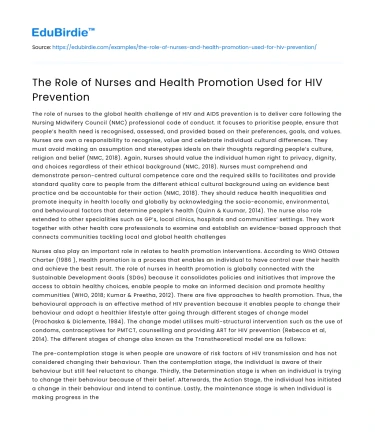The role of nurses to the global health challenge of HIV and AIDS prevention is to deliver care following the Nursing Midwifery Council (NMC) professional code of conduct. It focuses to prioritise people, ensure that people’s health need is recognised, assessed, and provided based on their preferences, goals, and values. Nurses are own a responsibility to recognise, value and celebrate individual cultural differences. They must avoid making an assumption and stereotypes ideals on their thoughts regarding people’s culture, religion and belief (NMC, 2018). Again, Nurses should value the individual human right to privacy, dignity, and choices regardless of their ethical background (NMC, 2018). Nurses must comprehend and demonstrate person-centred cultural competence care and the required skills to facilitates and provide standard quality care to people from the different ethical cultural background using an evidence best practice and be accountable for their action (NMC, 2018). They should reduce health inequalities and promote inequity in health locally and globally by acknowledging the socio-economic, environmental, and behavioural factors that determine people’s health (Quinn & Kuumar, 2014). The nurse also role extended to other specialities such as GP’s, local clinics, hospitals and communities’ settings. They work together with other health care professionals to examine and establish an evidence-based approach that connects communities tackling local and global health challenges
Nurses also play an important role in relates to health promotion interventions. According to WHO Ottawa Charter (1986 ), Health promotion is a process that enables an individual to have control over their health and achieve the best result. The role of nurses in health promotion is globally connected with the Sustainable Development Goals (SDGs) because it consolidates policies and initiatives that improve the access to obtain healthy choices, enable people to make an informed decision and promote healthy communities (WHO, 2018; Kumar & Preetha, 2012). There are five approaches to health promotion. Thus, the behavioural approach is an effective method of HIV prevention because it enables people to change their behaviour and adopt a healthier lifestyle after going through different stages of change model (Prochaska & Diclemente, 1984). The change model utilises multi-structural intervention such as the use of condoms, contraceptives for PMTCT, counselling and providing ART for HIV prevention (Rebecca et al, 2014). The different stages of change also known as the Transtheoretical model are as follows:
Save your time!
We can take care of your essay
- Proper editing and formatting
- Free revision, title page, and bibliography
- Flexible prices and money-back guarantee
The pre-contemplation stage is when people are unaware of risk factors of HIV transmission and has not considered changing their behaviour. Then the contemplation stage, the individual is aware of their behaviour but still feel reluctant to change. Thirdly, the Determination stage is when an individual is trying to change their behaviour because of their belief. Afterwards, the Action Stage, the individual has initiated a change in their behaviour and intend to continue. Lastly, the maintenance stage is when Individual is making progress in their new behaviour and are working hard to prevent a setback. The transtheoretical model supplies the recommended plan of action for public health interventions used to address people at different stages of the decision-making process. However, it does not consider the individual social-economic situation that contributes to a change (Wayre & LaMorte, 2019).
The role of nurses to the stages of change model is to build patients to nurse relationship by showing empathy and compassion, assess an individual’s capacity and create awareness on sex education, use of a condom, contraceptives to prevent unwanted pregnancy and PMTCT. Also, nurses are expected to motivate and support the individual on the need to change their behaviour this could be face to face and telephone appointment, establish an action plan on physical examination, HIV testing and baseline blood test to prevent further transmission. When a diagnosis is made nurses should commence immediate treatment of ART to patients, administer ARV drug, provide emotional support and promote ART mostly patients on pregnant mother from their first antenatal check for PMTCT and them to disclose sexual status to their partners. Consequently, there is no cure for HIV infection. Hence, ARV drugs are effective to increase 30% uptake of ART control 26% of viral load suppression in the body, minimise transmission so that individual will live longer (HIV.ORG, 2020; Rosen et al., 2016).
HIV and AIDs is a global challenge that has no cure. However, several treatments have been implemented globally through policies, initiatives and health promotion approach to improving the health and well-being of those infected. To achieve the UNAIDS 90-90-90 Fast- Track- Target, every country must ensure that different strategies put in place are functioning effectively without being against a certain group of people. Again, using a multisectoral sufficient funded relevant evidence-based health promotion programme that will address health inequalities and prompt inequity in health is highly recommended to achieve a positive result. Nurses are demanded to always practice following the professional code of conduct to deliver cultural competence standards care. A failure to comply to above mention the UNAIDS target will not be achieved by 2030.






 Stuck on your essay?
Stuck on your essay?

